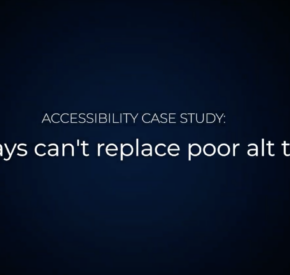Digital Accessibility 101 with Amanda Roper

Amanda Roper, Program Manager at Tamman discusses some basics of digital accessibility.
Transcript
Note:
This video is an interview presentation that includes text. Electric sound effects begin and then upbeat music plays.
On screen:
Tamman logo animation. Amanda Roper seated on a blue couch with two accent pillows, to the left is a potted plant, the background is a window looking out to trees. Amanda Roper, A11y Program Manager.
Amanda:
Accessibility is important for a lot of reasons. Digital accessibility is really important, because access to information is a human right. Accessibility in general, in broader terms, is very important.
On screen:
Tamman logo. Americans with Disabilities Act 1990 (ADA). The ADA is a civil rights law that prohibits discrimination against individuals with disabilities in all areas of public life, including jobs, schools, transportation, and all public and private places that are open to the general public. Source: adata.org.
Amanda:
The ADA over 30 years ago now declared that it’s a human right to make, not only properties and infrastructure accessible to people with disabilities, but also information needs to be accessible and a lot of that information today lives online.
On screen:
Tamman logo. Amanda Roper seated on a blue couch with two accent pillows, to the left is a potted plant, the background is a window looking out to trees. Amanda Roper, A11y Program Manager.
Amanda:
And so, since the ADA was signed into law over 30 years ago, a lot has changed in the digital sphere. And, we as a technology company have done a lot.
On screen:
Closeup of hands using braille assistive technology.
Amanda:
Excuse me. Not just we, as a technology company, but other people in addition to Tamman who are working to build the accessible web have done a lot to try to ensure that people with disabilities are able to access any sort of information that they may need and create that equal experience for someone who has disabilities to somebody who doesn’t have a disability.
On screen:
Tamman logo. Amanda Roper seated on a blue couch with two accent pillows, to the left is a potted plant, the background is a window looking out to trees. Amanda Roper, A11y Program Manager.
On screen:
Closeup of hands using braille assistive technology.
On screen:
Tamman logo. Amanda Roper wearing glasses and a patterned dress, seated on a blue couch with two accent pillows, to the left is a potted plant, the background is a window looking out to trees. Amanda Roper, A11y Program Manager. Certified Professional in Accessibility Core Competencies (CPACC). Issued by International Association of Accessibility Professionals, The CPACC is foundational certification, representing broad, cross-disciplinary conceptual knowledge about disabilities, accessibility and universal design, and accessibility-related standards, laws, and management strategies. Source: accessibilityassociation.org.
Amanda:
The CPACC exam is something that I recommend to any designer, any developer, manager, HR person, anybody who is starting their journey in accessibility, because not only does it cover accessible web design and how to make the web accessible, it also covers….
On screen:
Tamman logo. Amanda Roper seated on a blue couch with two accent pillows, to the left is a potted plant, the background is a window looking out to trees. Amanda Roper, A11y Program Manager. Principles of Universal Design. Guidelines for creation of accessible spaces, both physical and digital.
Amanda:
The seven universal design principles, which really allows you to just reframe the way that you’re thinking. So that has had an impact on my everyday life. I just- frankly, I just look at things differently now. I look at doorknobs. I look at sidewalks that have cracks in them. I know that a user- or excuse me, I know that somebody in a wheelchair may not be able to get around in our city and it just creates this fire in my gut, just knowing that that is not right for a significant population in the country. And, it makes me want to make things better.
On screen:
Toddler wearing hearing aid, wearing an orange and blue striped shirt with red pants, playing in the sand.
Amanda:
Somebody with a permanent disability may have been born with a disability and has been a part of that community since birth.
On screen:
Fade to mother in pink shirt holding a baby with one hand and a smartphone with the other.
Amanda:
Somebody with a situational disability might be something as simple as a mother carrying her child on her hip and needs to access her cell phone using only one hand.
On screen:
Person with a large bandage over their right eye.
Amanda:
An example of somebody with a temporary disability might be for example you had Lasik eye surgery and for a period of time you were not able to see.
On screen:
Tamman logo. Amanda Roper seated on a blue couch with two accent pillows, to the left is a potted plant, the background is a window looking out to trees. Amanda Roper, A11y Program Manager.
Amanda:
However after a period of weeks and after some healing, you were then able to use your computer as normal. Another temporary one may be a broken arm.
On screen:
Person in pink tank top with cast on arm and close up of doctors right hand with a pen over a green clipboard with paper.
Amanda:
Personally I’m right handed. If I broke my right arm, it would be- I would have to make a few adjustments to be able to work normally and access information the same way that I used to.
On screen:
Tamman logo. Amanda Roper seated on a blue couch with two accent pillows, to the left is a potted plant, the background is a window looking out to trees. Amanda Roper, A11y Program Manager.
Amanda:
When you’re making accessibility changes, it’s- you have one person in mind sometimes. So sometimes you’re designing for one person. However, most of the time it’s good for everybody. So, we like to use curb cuts as an example. I know that’s more of a physical thing, but curb cuts are not only great for somebody who is in a wheelchair but they’re also extremely convenient for mothers that are pushing strollers, kids on bikes. Like, there are countless ways that that one change has improved the lives of so many people.
On screen:
Tamman logo animation. Electric sound effect.





